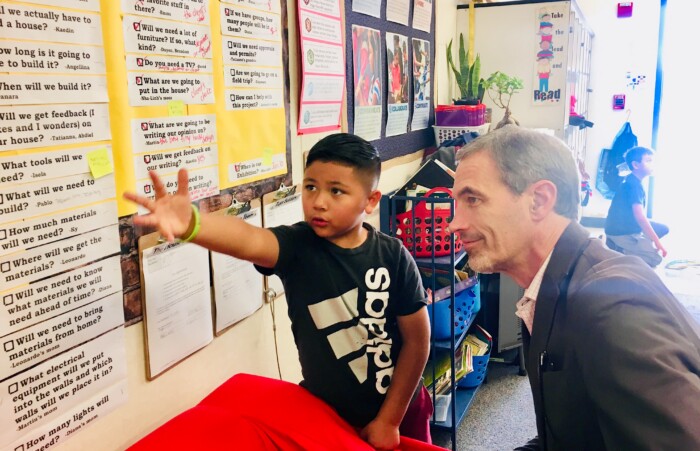Challenges and Opportunities
Credentialing has the potential for massive impacts on the education sector. Here are some of the challenges and opportunities shaping this impact.
6.1 Innovation
6.2 Challenges
6.3 Opportunities
6.4 Conclusion


Innovation
A modification on IDEO’s original desirability, verifiability and feasibility (DVF) analysis for innovation serves as an excellent foundation to evaluate the impact of credentialing. Despite the clear match described below, challenges and opportunities exist to scale the solution.
- Viable. Viability asks whether resources (both human and financial capital) exist to support an innovation. For a credentialed learning ecosystem, massive incentive exists on the employer side to find talent that matches critical skill sets. Credentialed learning saves time and money, which provides incentive for capital funding to scale.
- Feasible. Feasibility asks whether we know how to build this innovation. For credentialed learning ecosystems, each element is present and, with advances in the technology of credentials (interoperability, data standards, etc.), blockchain decentralized locations for storage and sharing (digital wallets as part of the LER solution), and matchmaking (linking employment opportunities to learner credentials), demonstrate the building blocks of a full ecosystem.
- Desirable. Critical to any innovation is whether or not it is desirable: Do people want the solution? In the case of a credentialed learning ecosystem, we predict that desirability will increase as ease of use improves (see below for challenges and opportunities). A linked ecosystem that allows individuals to store credentials, share credentials, and gain opportunities through credentials is appealing to educators, learners, and employers.
- Beneficial. A seamless connection between learning and earning throughout a lifetime increases equitable access for all individuals. Moving beyond degrees as a proxy for talent creates better options for both the individual and their future employer.
Challenges
Equity. Any future credentialed ecosystem faces the risk of a foundation that is based on historical equity challenges. From design to implementation, the ecosystem must be built with and for everyone, with attention and leadership from those traditionally marginalized in education and employment systems. Digital Promise’s Inclusive Design Principles provide an excellent example for those building Learning and Employment Record technology.
Scale. The scale of competency that is credentialed is still limited. Core competencies are credentialed through a diploma, which provides limited visibility into the specific skill sets of an individual. Transferable competencies are rarely credentialed, reducing transparency into an area that is defined as high-need by employers.
Regulation. Companies that support the skills-based credential market have difficulty protecting their training program outputs (due to federal regulation). Incentive levels are low for companies to invest in credentialing training programs and/or demonstrated work competence given that an employee may use this data to leave the company. Within higher education, limited recognition by offices of admission and limitations related to NCAA requirements and Pell Grant recipients hinder credential success.
Market. A credentialed learning ecosystem can only scale and thrive with a two-sided market. Both supply (providing individual learners with ready access to their credentials describing competency) and demand (from employers and/or higher education) are still weak except in certain areas (like IRCs).
Portability. The variability of data structures, state regulations, formats, and redundancy make it difficult to effectively share credentials. By unifying data structures and building technology that allows users to easily transport credentials will rapidly address this challenge. As an example, the Diploma Supplement (p. 24) describes detailed skills of applicants for all potential students in the European Union. In the United States, the U.S. Chamber of Commerce supports the T3 Innovation Network to better align the talent marketplace through skills-based hiring and advancement.
Value. Only part of an individual’s learning journey is currently credentialed (such as a diploma, IRC). These are the only elements that hold value for either higher education or the HR offices of employers. There is increasing value in core competency credentials and transferable competency credentials
Trust. As the credentialed learning ecosystem grows, trust in the system needs attention. Accreditation systems around credentialing additional parts of the ecosystem will increase trust in the network at large.
Opportunities
The credentialed learning landscape has multiple opportunities. Below we articulate opportunities across multiple sectors and provide examples of those working within the space.
What to Credential?
K-12
Incentivize the replacement of course grades with competencies leading to credentials. National Career Readiness Certificate (ACT)
Incentivize the development of transferable competencies leading to credentials. XQ Learner Outcomes
Develop a credential transcript that has value. Mastery Transcript Consortium
Build K-12 and employer partnerships for real-world learning that can lead to credentials. GPS Ed
Higher Education
Develop standard protocol for admissions offices to recognize competency credentials as a replacement for a traditional transcript. Performance Assessment in College Admission
Collaborate with NCAA and Federal Government Pell Grant departments to accommodate and value competency-based systems that award credentials. Aurora Institute and National Skills Coalition
Build a coalition of higher education institutions that award credentials for stacked sets of competencies earned through parts of courses (which in turn provides value to those students who do not complete a traditional degree credential). Credential As You Go
Employers
Support technology platforms that allow employers to easily credential competencies earned by employees during work experience. C.Ti
Conduct alignment research (with annual updates) to articulate a core set of transferable competencies and verified credentials most needed by employers. JFF
Research and share case studies of employer badging and credentialing programs. IBM
Expand work-based partnerships with higher education to provide multiple opportunities for real-world experience and credentialing while enrolled in school. Upskill Together
How to Credential?
K-12
Build technology to allow community learning experiences (out-of-system) to link to competency and connect to credentials. Headrush Learning
Invest in state-sponsored initiatives to create verified digital credential solutions for K-12 education. North Dakota
Support Web3 initiatives to build innovative distributed models of learning that lead to credentials. Ed3 DAO
Create seamless pathways between verifier and learner through blockchain and digital wallets. Web3 Credentials Primer
Identify industry and college partners to validate existing high school experiences and competencies. Del Lago Academy
Employers
Invest in Human Resource technology development to build and adopt better skills matching solutions to link credentials with open positions. Velocity Network Foundation
Provide a standard set of transferable and core competencies for employers to use to develop credential programs. America Succeeds Durable Skills
Build agreements on common transferable competencies and credentials shared by higher ed and employers. Wellspring Initiative
Who Should Credential?
K-12
Promote “Learn Everywhere” legislation, which would allow alternative learning providers to offer experiences that lead to credentials. Colorado Succeeds
Catalog and amplify successful high school badging programs based on regional need. Victory College Prep and VLACS
Higher Education
Invest in and support organizations that aid higher education in increasing granularity of coursework through competencies and credentials. Burning Glass Institute
Identify strong higher education and high school partnerships focused on dual enrollment and competency-based approaches. Da Vinci ConnectX
Employers
Create toolkits to support employers in the implementation of work-based credentialing programs. Education Strategy Group
Conclusion
When learning is credentialed, every individual has a better opportunity to succeed academically, find a learning pathway that meets their goals, and match with education and employment opportunities that fit their skill set. Educational institutions have a better understanding of student skill acquisition through core, transferable, and technical competencies. Employers reduce retraining and missed hires, and get the needed talent to accelerate business. The technological barriers to award, store, and share verified credentials through digital wallets and interoperability standards are diminishing. Still, for the rest of this decade, learners will likely need to accumulate both course credits AND credentials and will need either an extended transcript or LER capable of transmitting both old and new forms of evidence. While deconstructing historical practices of courses to grades to diploma credentials to employment based on inefficient, inaccurate, and inequitable systems of skills assertion is a formidable challenge, enough tested examples now exist to scale credentialed learning throughout the learning to employment ecosystem.

